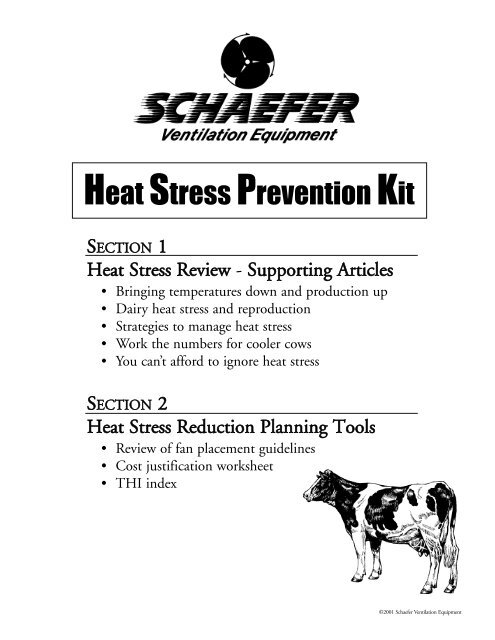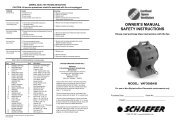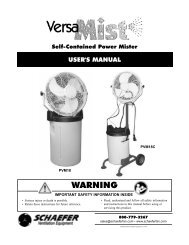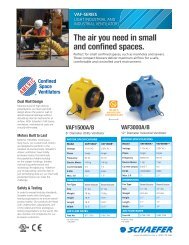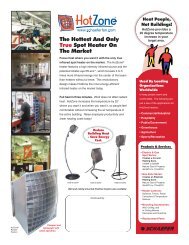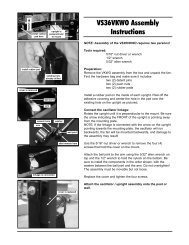Heat stress cover dairy.qxd - Schaefer Ventilation Equipment
Heat stress cover dairy.qxd - Schaefer Ventilation Equipment
Heat stress cover dairy.qxd - Schaefer Ventilation Equipment
Create successful ePaper yourself
Turn your PDF publications into a flip-book with our unique Google optimized e-Paper software.
<strong>Heat</strong> Stress Prevention Kit<br />
SECTION 1<br />
<strong>Heat</strong> Stress Review - Supporting Articles<br />
• Bringing temperatures down and production up<br />
Dairy heat <strong>stress</strong> and reproduction<br />
Strategies to manage heat <strong>stress</strong><br />
Work the numbers for cooler cows<br />
You can’t afford to ignore heat <strong>stress</strong><br />
SECTION 2<br />
<strong>Heat</strong> Stress Reduction Planning Tools<br />
Review of fan placement guidelines<br />
Cost justification worksheet<br />
THI index<br />
©2001 <strong>Schaefer</strong> <strong>Ventilation</strong> <strong>Equipment</strong>
Section 1<br />
<strong>Heat</strong> <strong>Heat</strong> Stress Stress Review<br />
Review<br />
Supporting Supporting Supporting Articles<br />
Articles
American Society of Animal Science<br />
American Dairy Science Association<br />
Bringing Temperatures Down Keeps Dairy Production Up<br />
DES MOINES, Iowa – Keeping <strong>dairy</strong> cows from overheating during hot weather is a key to maintaining<br />
production levels and reproduction, a <strong>dairy</strong> expert from Kansas State University says.<br />
"<strong>Heat</strong> <strong>stress</strong> can cause losses in production of 20 percent or more and reduce conception rates from 10 to 20<br />
percent," says John Smith an extension <strong>dairy</strong> specialist. Producers need to look for ways to reduce that <strong>stress</strong><br />
without adding significant costs to production, he adds.<br />
Dairy experts agree that heat <strong>stress</strong> for <strong>dairy</strong> cows begins to take its toll when the temperature/humidity index<br />
reaches 72 degrees. "The severity and duration of the heat <strong>stress</strong> is going to depend on local conditions. In<br />
some areas, heat <strong>stress</strong> is almost never a concern, and in others, it’s nearly constant," Smith says. "That means<br />
the steps taken to reduce heat <strong>stress</strong> will be different on every farm."<br />
In a presentation to researchers and extension specialists at the joint Midwest meeting of the American Dairy<br />
Science Association and the American Society of Animal Science in Des Moines, March 17, Smith outlined<br />
key strategies for reducing heat <strong>stress</strong>. He recommends adopting the recommendations in the order they’re<br />
listed here. Each step to reducing heat <strong>stress</strong> comes with a cost, he notes, so producers need to carefully consider<br />
whether the benefits will justify the expense.<br />
First, provide adequate cool, clean water. Smith says providing enough water for cows as they leave the<br />
milking parlor and in housing will go a long way toward keeping cows cool. Cows rely on evaporation of<br />
moisture from the respiratory tract and from sweating for cooling. In dehydrated cows, this natural cooling<br />
system is crippled.<br />
Second, find ways to reduce walking distance to the milking parlor. Minimizing effort helps cows keep<br />
their cool, Smith explains. And minimize time cows spend in the milking parlor’s holding pen. "Those<br />
cows are like a bunch of large furnaces in a small room with no place for the heat to go," he says.<br />
Next, provide shade in the holding pen and in cow housing. Keeping the sun off cows can dramatically<br />
reduce temperature.<br />
Provide a holding pen cooling system and exit lane cooling. Smith notes that the holding pen and parlor<br />
are relatively harsh environments because of the amount of heat generated in that small space. Although<br />
fans and sprayers are expensive, keeping cows cool in the holding pen and cooling them rapidly as the leave<br />
the milking parlor may reduce <strong>stress</strong> enough to make those systems pay, he says.<br />
Finally, provide cooling systems in cow housing ares and along feedlines. Although this is the most<br />
expensive option for cooling cows, it may be necessary to keep cows producing at optimum levels.
Dairy <strong>Heat</strong> Stress and Reproduction<br />
Prolonged hot weather adversely affects reproductive performance of cattle. As the quality and quantity of feed<br />
decline some cows may become anestrus (stop cycling). For those cows or heifers that continue to cycle the<br />
duration of estrus and expression of estral signs are reduced. Irregular intervals between heats may be noticed.<br />
Lower pregnancy rates should be expected because of the higher rate of fertilization failure and embryonic<br />
death. This is likely due to alteration of normal development of the oocyte that is about to ovulate and the<br />
early developing embryo. There is also a direct effect on uterine function. The oocyte and the early embryo<br />
can not produce heat shock proteins during heat <strong>stress</strong> and thus their viability is reduced. Research from<br />
Florida showed that embryos become more resistant to elevated temperature as they develop because they<br />
acquire protective mechanisms against heat <strong>stress</strong>. It has been estimated that a rise in uterine temperature by<br />
.90F causes a 12.8% decrease in conception rate. In addition, it has been shown that during the dry period<br />
heat <strong>stress</strong> can alter development of the placenta. Again work from Florida showed that heat <strong>stress</strong> during the<br />
last trimester of pregnancy affected placental function resulting in lower birth weights.<br />
Obviously any management practice that reduces thermal <strong>stress</strong> and maintains feed intake should help<br />
minimize reproductive loss. Use of overhead fans and properly designed sprinkler systems will reduce <strong>stress</strong>.<br />
It may be helpful to decrease the number of animals per unit area. Provide shade over bunks and plenty of<br />
good water especially for cattle on pasture. Utilize buffers in the ration and insure adequate levels of potassium.<br />
Feed more times per day. Observe for estrus more frequently and during the cooler periods of the day - early<br />
morning and later in the evening. The adverse effects of hot weather on reproduction will vary from farm to<br />
farm depending upon how effectively heat <strong>stress</strong> is minimized, feeding management, cow comfort and the<br />
intensity of heat detection.<br />
Cattle producers using natural service bulls should be aware that prolonged high temperature can severely<br />
effect a bull's ability to maintain optimal scrotal and testicular temperature. Higher testicular temperature will<br />
suppress sperm production and cause production of abnormal sperm cells. Low sperm output and poor semen<br />
quality can be expected and, consequently poor pregnancy rates will result. Since spermatogenesis is such a<br />
long process, this effect will continue for several weeks or a month even though temperatures begin to<br />
moderate. If cows are still cycling normally and in good condition but bull fertility is suspect, then artificial<br />
insemination may be a good alternative.<br />
Michael L. OUConnor, Professor of Dairy Science<br />
Penn State University<br />
324 Henning Building<br />
University Park, PA 16802<br />
814-863-3913<br />
Document Number: 28902138
Strategies to Manage <strong>Heat</strong> Stress in Dairy Cows<br />
University of Missouri-Columbia<br />
Water<br />
When temperatures are high, daily water consumption can increase from 15 to 40 gallons per cow. Dairy cows<br />
require approximately 3-4 pounds of water for each pound of milk produced. Factors limiting water intake<br />
include a high salt content, high iron or sulfur, and stagnation. Some blue green algae are even toxic.<br />
Management practices to improve water intake:<br />
Locate the cows’ water near the feeding area. Placing a small water tank in a corner of the<br />
holding pen has increased milk production 2 to 4 pounds per cow.<br />
Shade the water tank. Researchers from Texas A&M observed that when cows were offered<br />
cool water versus warm water, cows drank more, consumed more feed, and milk yield<br />
increased 4.8%.<br />
Provide adequate watering space — at least one watering space or 2 feet of tank perimeter<br />
for every 15 to 20 cows.<br />
Shade<br />
Properly constructed and maintained shades are effective in reducing heat <strong>stress</strong>. A north-south orientation<br />
with 30-40 square feet per cow will provide adequate shade. Shades should be a minimum of 10 feet high and<br />
no more than 30 feet wide to allow for drying underneath.<br />
A portable shade can be constructed using nylon mesh, which blocks 70 to 90 percent of the sunlight. The<br />
advantages of the mesh screens are that they allow air movement and drying underneath, and cost<br />
approximately 25 to 30 cents per square foot.<br />
Freestall Barn Management<br />
A correctly designed and managed freestall barn can provide relief from heat. Design criteria should include a<br />
roof slope of four-twelfths, eave height of 12 feet and a ridge opening relative to the width of the building.<br />
Freestall barns should be constructed with curtains on the sides, so that the barn can be opened to improve air<br />
movement.<br />
Air Movement<br />
Fans can greatly enhance evaporative cooling and cow comfort. Locate fans above the freestall. Large fans<br />
should be 3 to 4 feet in diameter, providing 500 to 600 cubic feet per minute per cow. A rule of thumb for<br />
effective air movement for a fan is 10 times the diameter in feet, for example, a 3-foot fan will move air for<br />
approximately 30 feet.<br />
Freestall Beds<br />
Straw is hot—sand is cool. If bedding with sand, be sure to place at least 4 inches in the stall and add sand<br />
every 2 to 4 weeks. Sand should not be used with some types of waste-handling systems. A sand or rubberfilled<br />
mattress is another option. Sprinkle a little bedding on the mattress to keep the surface clean.<br />
Sprinklers<br />
Sprinklers can help with evaporative cooling. It is important to thoroughly wet the hair coat to ensure<br />
effectiveness. Sprinklers should be installed above the cows over a hard surface, such as near feed bunks or a<br />
feeding alley. Suggested on/off time is approximately 15 percent on and 85 percent off, controlled with a timer.<br />
Sprinklers should be located approximately 8 feet above the cow and 4-6 feet from the feeding area; water<br />
pressure from 10 to 25 PSI with nozzles delivering 1½ to 4 gallons per minute.<br />
Contact: Barry Steevens<br />
Outreach and Extension Dairy Specialist<br />
University of Missouri-Columbia
Work Work the the Numbers Numbers for for Cooler Cooler Cows<br />
Cows<br />
By Lloy Griffing,<br />
<strong>Schaefer</strong> <strong>Ventilation</strong> <strong>Equipment</strong><br />
The modern <strong>dairy</strong> operates on numbers – pounds of milk, feed intake, days in milk, and dozens of other variables.<br />
Cow comfort is all about numbers, too. Dairy scientists are giving us more and more quantifiable evidence that<br />
comfort is a key factor in running a profitable operation.<br />
Recent studies support what producers have always known – heat <strong>stress</strong> can rob you of up to 25% of your milk<br />
production. Not only do you lose production on hot days, but production suffers for the rest of the lactation cycle<br />
as well. The impact on reproductive efficiency can be just as significant as the loss of milk.<br />
The inescapable conclusion from each of these studies is that mechanical ventilation is a must for every <strong>dairy</strong>.<br />
Remember, heat <strong>stress</strong> starts when temperatures hit the low 70’s and humidity is high. Also be aware that cows<br />
don’t cool as fast as people. After a hot day, <strong>dairy</strong> scientists strongly recommend running fans at night to lower<br />
core body temperatures in order to prepare the animal for the next day’s heat.<br />
Although each <strong>dairy</strong> is different, most scientists, equipment dealers and producers are recommending some<br />
combination of fans and mist or sprinklers arranged over stalls, feed lanes, holding pens and the parlor. Enclosed<br />
tie-stall facilities might also use exhaust fans and evaporative cooling pads.<br />
As a producer, you want to know how<br />
soon you’ll see a return on your ventilation<br />
investment. We’ve worked with dealers<br />
across the country to develop a simple yet<br />
effective worksheet that considers the losses<br />
incurred from heat <strong>stress</strong> as well as the cost<br />
of installation & operation of a custom<br />
ventilation system.<br />
Here’s how family-owned Dorrich Dairy<br />
in Glenwood, Minnesota used these<br />
numbers to make a ventilation decision last<br />
year:<br />
Dorrich Dairy took a beating from the<br />
heat in the summer of 1998. Co-owner<br />
Brad Vold estimates their 300-cow <strong>dairy</strong> in<br />
west-central Minnesota lost over 17<br />
Owners Brad and Richard Vold<br />
pounds of milk per cow per day during a<br />
heat wave in July of that year. Vold said: “During the months of June-August 1998, our butterfat test averaged<br />
3.48 and our protein was 3.10. Our conception rate fell to around 27% for those same months. It was time to do<br />
something.”<br />
Dorrich Dairy worked with Stearns Veterinary Outlet in Melrose, MN to put a fan plan together. Manager Don<br />
Brower sat down with the Vold and gathered information about the number of cows milking, loss from heat <strong>stress</strong>,<br />
number of heat <strong>stress</strong> days, and estimated price of milk.<br />
Next, Brower went back to the office and estimated a fan and mister installation for Dorrich Dairy that included<br />
thirty 36” fans in the main freestall barn, two 36” fans in the treatment barn and three 24” fans with misters in the<br />
holding pen.
When the proposal was complete, he added the cost of the fans, installation and operation to the numbers provided<br />
by Dorrich Dairy and calculated the amount of time a ventilation system would pay for itself. In this case, the<br />
owners saw that the projected payback time was only seven months with the most aggressive estimate of loss<br />
prevention, and 14 months for the most conservative estimate.<br />
Did the fans make a difference? Here are the numbers: during the hottest week of 1999, from July 22 through<br />
August 1, milk fell only 6.8 pounds per cow as compared to 17 lbs the year before. For the summer months,<br />
butterfat averaged 3.6, while protein was 3.1. “Our conception was a more respectable 36%”, said Vold.” Dry<br />
matter intake was also .59 lbs above summer 1998 levels.<br />
(See table below)<br />
“The loss of milk, the reproduction problems and other herd health issues we experienced in 1998 took close to 18<br />
months to overcome. Fortunately, we did not have to worry about those problems in 1999.”<br />
The key to making a decision for profitable cow comfort is to work the numbers. A trusted <strong>dairy</strong> equipment<br />
supplier should be able to help you put together the right numbers for a sound financial decision.<br />
Lloy Griffing helps <strong>dairy</strong> equipment dealers and producers to plan and implement livestock cooling systems. He can be<br />
reached at <strong>Schaefer</strong> <strong>Ventilation</strong> <strong>Equipment</strong>, 800-779-3267 or lloyg@schaeferfan.com<br />
No fans were used in the summer of 1998.<br />
35 fans were used in the summer of 1999.<br />
1998 1998<br />
1999<br />
Milk loss in pounds 17.1 6.76<br />
Butterfat 3.48 3.6<br />
Protein 3.1 3.1<br />
Conception rate 27% 36%
Section 2<br />
<strong>Heat</strong> <strong>Heat</strong> Stress Stress Reduction<br />
Reduction<br />
Planning Planning Planning Tools<br />
Tools
Prevent <strong>Heat</strong> Stress to Improve Profits<br />
You’ve probably seen the results of heat <strong>stress</strong> on your <strong>dairy</strong>. If you can examine your production records<br />
and correlate air temperature to milk production, you might find some alarming trends.<br />
<strong>Heat</strong> <strong>stress</strong> can begin at 72 o F and<br />
high humidity<br />
Cows produce a lot of heat, about 5,500 BTU’s per hour for a cow<br />
producing 85 pounds of milk per day. The thick hide on a cow traps<br />
the heat, keeping her hot well after the sun has gone down. Extended<br />
hot days, even two or three in a row, can dramatically lower milk<br />
production.<br />
Evidence also shows that cows can take months to re-establish their<br />
high milk production levels after they’ve been <strong>stress</strong>ed by heat.<br />
Additionally, heat <strong>stress</strong> can have long term negative effects on<br />
reproduction and disease.<br />
<strong>Heat</strong> Stress<br />
Cows produce milk most efficiently when the ambient temperature is between 35 and 65 degrees<br />
Fahrenheit, often referred to as their comfort zone.<br />
With high humidity, heat <strong>stress</strong> can begin as temperatures rise above 72F. Refer to the attached<br />
Temperature-Humidity index (THI) for <strong>dairy</strong> cattle to see how temperature and humidity can effect your<br />
cows. A THI of 72 or above is generally considered <strong>stress</strong>ful. During hot weather, listen to local weather<br />
reports for the THI in your area.<br />
<strong>Heat</strong> Stress can have long term consequences. In the summer of 1995,<br />
most <strong>dairy</strong> farmers in Wisconsin experienced up to 25% reduction in milk<br />
production due to heat <strong>stress</strong>, with delayed re<strong>cover</strong>y. (Brian Holmes, WI<br />
extension engineer, in MN/WI Engineering Notes for the U of M Biosystems &<br />
Ag. Eng. Dept.) Further reports indicated milk production was effected well<br />
into the following winter.<br />
<strong>Heat</strong> can also reduce the reproductive efficiency of <strong>dairy</strong> cows. “The<br />
most apparent problems are difficulty in detecting estrus and low fertility<br />
when cows are inseminated.” (Dr. John Fuquay, professor of <strong>dairy</strong> science,<br />
quoted in Mississippi Farmer).<br />
“<strong>Heat</strong> <strong>stress</strong> can be<br />
responsible for drops in<br />
milk production of 15% to<br />
25% or more.”<br />
Bill Crist, U of Kentucky extension<br />
<strong>dairy</strong> specialist, quoted in the<br />
Ketucky Farmer, July 1996)
Prevention<br />
The single most important key to heat <strong>stress</strong> management is prevention! We can not control the weather,<br />
but we can take steps to control the effects of weather. It isn’t very complicated at all. The first step is shade,<br />
the second step is an appropriate amount of fans, and step three is misted water. That’s really all there is to<br />
it. Here’s where you can prevent heat <strong>stress</strong>:<br />
Fans mounted in<br />
holding pen<br />
The Holding Pen: “The holding pen is the single worst environment on the<br />
<strong>dairy</strong>.” (Dennis Armstrong, U of Arizona <strong>dairy</strong> specialist, quoted in The<br />
Dairyman, April 1993). Every cow spends 30 to 60 minutes in a crowded<br />
holding pen several times a day. Each time through is a hot, humid,<br />
crowded, <strong>stress</strong>ful, ordeal. The main objective is to better the conditions<br />
with the use of air movement. The cows are already wet, so moving air over<br />
them results in highly effective evaporative cooling.<br />
Mount a 36” fan to the top of the holding pen ceiling every 30 ft of length,<br />
and each 15 ft of width. In dry climates, when humidity is under 50%, attach mist kits to the front of each<br />
fan. The mist kits will provide an evaporative cooling effect. Angle the fans down approximately 20 degrees<br />
so they are blowing onto the cows backs. It is recommended that the fans face the opposite direction of the<br />
milking parlor to prevent moving dust and humidity into the parlor. Fans in the milking parlor are a good<br />
idea as well. Mount 24” or 36” fans to face the holding pen so all fans are facing the same direction.<br />
The Feedline: Feedline cooling is important because if you provide a comfortable place for the cows to eat,<br />
they will stay and eat! Shade the feed bunk and use fans to provide air movement as they eat. Cows are not<br />
likely to leave whatever relief they have found to go stand in the hot sun to eat. When you have provided<br />
relief with shade, fan and mist, the cows are content to eat as much as they<br />
want.<br />
Free Stalls and Green Barns: In these operations, cooling fans can be very<br />
effective. Although naturally ventilated, it is important to understand that<br />
fans cool cows, not the building. Since cows spend most of their time<br />
here, fans and mist kits will help prevent heat <strong>stress</strong> from taking a big bite<br />
of milk production. Mount 36” fans above the cows, angled at 20 degrees,<br />
every 30 ft. Mount the fans to move air in the direction of any prevailing<br />
winds.<br />
If your cows leave a fan cooled barn, enter a fan cooled holding pen and<br />
milking parlor, then eat in a fan cooled feed bunk, you have done<br />
everything you can do to eliminate heat <strong>stress</strong> on your <strong>dairy</strong>.<br />
Typical free stall fan<br />
installation<br />
©2000 <strong>Schaefer</strong> <strong>Ventilation</strong> <strong>Equipment</strong>
Dairy Cooling Cost Justification Worksheet<br />
Directions: Fill in information for lines 1, 2, 4, 6, 8, 9. Then perform the math functions to complete the worksheet.<br />
Savings from <strong>Heat</strong> Stress Prevention:<br />
Multiply by (x)<br />
Equals (=)<br />
Multiply by (x)<br />
Equals (=)<br />
Multiply by (x)<br />
Equals (=)<br />
1. _________ # of cows milking per day<br />
2. _________ Expected cow per day pounds of prevented lost production from relieved<br />
heat <strong>stress</strong>. (<strong>Heat</strong> <strong>stress</strong> can reduce milk production by as much as 25%. A range of<br />
5% to 25% can be used to estimate your prevented loss per day.)<br />
3. _________ Increased milk production per day in pounds.<br />
4. _________ Your price of milk per pound.<br />
5. _________ Total of income per day from heat <strong>stress</strong> relief.<br />
6. _________ Your average number of heat <strong>stress</strong> days. (See attached table for heat <strong>stress</strong><br />
index. Your <strong>Schaefer</strong> Fan dealer may also be able to tell you the average number<br />
of heat <strong>stress</strong> days in your area.)*<br />
7.$________ Dollars of increased income per year<br />
Cost Justification:<br />
8. _________ The total cost of installed 36" <strong>Schaefer</strong> Fans, mist kits, thermostats and controls.<br />
Ask your <strong>Schaefer</strong> Fan dealer to supply you with actual or approximate costs.<br />
Divided by (÷)<br />
Equals<br />
Multiply by (x)<br />
Equals (=)<br />
9. $_________The dollars of increased income per year (line 7)<br />
10.$_________Savings factor<br />
11. 12 Months<br />
12.__________The number of months before increased income has paid for the fans.<br />
Notes:<br />
*<strong>Heat</strong> <strong>stress</strong> can not be absolutely predicted for your <strong>dairy</strong>. Factors such as humidity, shade, exertion, wind and<br />
proximity and duration in a holding pen can all affect the severity of heat <strong>stress</strong>.<br />
•See back of this page for operating costs. •See accompanying page for heat <strong>stress</strong> index chart.
Yearly Operating Costs:<br />
Operating costs for a fan can be roughly estimated. All figures below are estimates only. Many variables<br />
can change these estimated costs.<br />
Fan<br />
VS36BKA - single phase at 230 volts<br />
running for 1 hour:<br />
Cost to operate fan for 1 hour based on low,<br />
med and high electric rates<br />
.06¢ kWh .08¢ kWh .12¢ kWh<br />
3.3 cents 4.4 cents 6.6 cents<br />
Check with your utility for rates in your area<br />
To estimate yearly operating cost, use the figure that most closely compares to your local Kwh rate x the<br />
number of fans needed for your <strong>dairy</strong> x the number of hours estimated to run per day x the expected<br />
number of days per year the fans will be used.<br />
For example, 40 fans running 10 hours a day will cost $17.60/day to run at an 8 cent kWh rate.<br />
Notes:<br />
A VS36BKB three phase may be significantly more energy efficient.<br />
© Copyright 2000 <strong>Schaefer</strong> <strong>Ventilation</strong> <strong>Equipment</strong>


